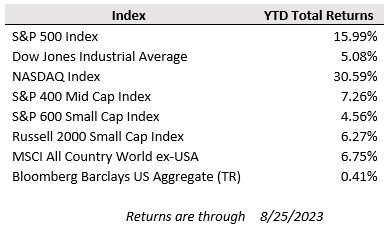U.S. equity markets broadly managed to eke out small gains amid last week’s turbulent trading and continued interest rate volatility. The week was highlighted by a highly anticipated speech from Federal Reserve Chairman Jerome Powell at the annual Jackson Hole Economic Symposium as well as an impressive earnings report from chipmaker Nvidia showing the significant acceleration in capital investment relating to generative artificial intelligence that has catalyzed the tech stock rally in 2023. Tech stocks led the way last week and recouped some of their August losses, lifting the tech-heavy Nasdaq Composite up 2.3%, while the S&P 500 gained 0.8% and the Dow Jones fell 0.4%.
In his comments on the progress of taming inflation and the path ahead, Fed Chairman Powell steered away from providing explicit expectations for future monetary policy changes and maintained a focus on being flexible and data dependent given still significant contradictory forces pulling inflation in opposite directions. He acknowledged that the surprising resilience of U.S. economic activity in the first half of the year, which now appears to be accelerating, opens the door to potential further rate increases. However, he also noted that the central bank is wary that the lagged impact of the considerable tightening that has already occurred has yet to be fully felt, requiring the Fed to “proceed carefully” in any further hikes.
Investors are split on the prospects of further rate hikes with fixed income markets pricing a 56% probability of at least one more rate increase before year end, according to the CME FOMC FedWatch Tool. However, the question at this point has shifted more to how long rates are sustained at these restrictive levels rather than what level short-term rates peak at. Rate cuts are currently expected to gain steam midway through 2024, according to Bloomberg, based on the current trajectory of inflation and economic growth.
Despite the recent equity market pullback so far in August in which the Nasdaq and S&P 500 have fallen by just over 5% and 3% respectively, the strong year-to-date rally has extrapolated out the goldilocks scenario of accelerating economic growth and falling inflation and interest rates. According to FactSet, earnings per share growth for the S&P 500 in 2024 is expected to accelerate to 12% after this year’s slowdown with EPS growth forecast to be just around 2% over 2022. Seven mega-cap tech stocks (Apple, Microsoft, Amazon, Nvidia, Alphabet, Tesla, & Meta) are expected to supply a large portion of that growth (nearly 29% of the growth in 2024 S&P 500 earnings according to consensus analyst forecasts from FactSet).
Artificial intelligence is seen as an important component in the next leg of growth for these tech heavyweights as they are among a small number of companies and institutions with the financial scale, proprietary data, and distribution capabilities needed to be successful against the considerable required investment. Last week’s earnings report from Nvidia gave insight into the goldrush for advanced AI chips as the company’s data center revenue nearly tripled from a year ago with over half of those revenues supplied by large cloud service providers like Microsoft, Amazon, and Alphabet. While the prospects of generative AI are exciting, many tech stock valuations have risen to extended levels that price in optimistic outcomes with little room for error. Additionally, much of the ultimate benefits and risks of AI investment remain uncertain, and its impacts on sales and cost efficiency will take time to come to fruition, while requiring substantial upfront spending that may be a headwind to near-term corporate earnings and free cash flow.
Looking to the week ahead, the economic calendar is packed with important readings, including an update on the Fed’s preferred inflation gauge (Personal Consumption Expenditures or PCE index) as well as the August jobs report. These two indicators will be important markers ahead of the Fed’s September meeting. Core PCE is currently expected to come in at 4.2% for July compared to a year ago (or 3.3% including food and energy prices), and job growth is expected to continue moderating with 155k new nonfarm payrolls forecasted to be added during August.


